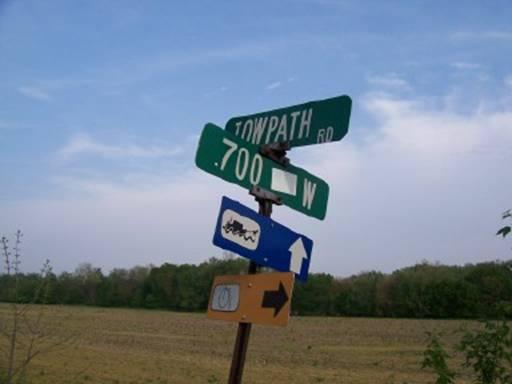|
Side trip - When you leave Pittsburg, turn southeast (left) on highway 421, which goes into Delphi and connects with Indiana 25. Approaching from the southwest, go to the second traffic light, which is at the corner of the Carroll County Court House on Main and Washington streets. Turn northwest (left) on Washington Street and proceed 11 blocks until you cross over the canal bridge. Go past the gravel drive and enter the Canal Park by turning left on the blacktop street that accesses Peters - Revington furniture factory and the long blacktop parking lot of the Canal Interpretive Center on the west side of the Canal Park. Look straight forward at the end of the lot and the large old looking (actually new) building is the museum. There is a kiosk with information to the left of the parking lot on the canal towpath. There are several historic buildings, including the 1844 Reed Case house, 2 log cabins and other buildings, an iron bridge (3 blocks to the north along the towpath trail), 3 miles of water-filled canal, and 10 miles of hiking trails. The big new building is the Wabash & Erie Canal Conference and Interpretive Center, opened in 2003. It shows the canal era with “state of the art” exhibits like the real water model of a canal and includes an operational reservoir, aqueduct, lock and grist mill. It also includes a picture of the Potawatomi Trail of Death. Burnett’s Creek Arch was part of the Wabash & Erie Canal. The Wabash & Erie Canal ran from Evansville, Indiana, on the Ohio River to Fort Wayne, Indiana, the watershed divide, then east to connect with Lake Erie at Toledo in northern Ohio. At 468 miles in length, it was the largest man-made structure in the United States in its day. The canal was being dug from 1832 to 1853. It reached the east side of Logansport late in 1837.  Canals were built with hand labor using picks, shovels, wheelbarrows and horse-drawn slip-scoops. Workmen were mainly Irish immigrants, many of whom died of cholera, fevers, snake bite, and from accidents while working the swamps and forest. In 1837 there were almost 5,000 laborers at work on Indiana’s public works, including canals, roads and railroads. By 1852 the W&E Canal was being used heavily. Farmers shipped their produce to sell in cities, and manufactured goods were hauled in to the small towns at reasonable prices. Travelers and immigrants used the horse-pulled canal boats. Mules were used to pull the freight boats. However, the expense of building railroads, turnpikes and other canals to connect to the main arterials - the Wabash & Erie Canal to the north and west and the Ohio River to the south - had contributed to the fledgling state of Indiana going into bankruptcy before its 30th birthday. One of the great ironies of history is that the canal boats were used to ship the rails from foundries for the railroads that put the canal system virtually out of business by the early 1870s. Delphi was platted in 1828 by Samuel Milroy, the same man who built the blacksmith shop and grist mill at Lake Manitou near Rochester in 1827, per terms of the 1826 Treaty with the Potawatomi. The canal was being dug while the Potawatomi Trail of Death took place. Unfortunately, the diarist did not record seeing the canal workers, because the canal was just opening at Logansport and would not reach Delphi until 1840. The Trail of Death went on the road now known as Towpath Road. This was the road that the mules and horses walked on when pulling the canal boats. Parts of the canal are still visible alongside Towpath Road. It is interesting to note that one reason Indiana Governor David Wallace insisted on the removal of the Potawatomi was so that he could sell their land to settlers to help finance roads and canals. Was it worth the cost in human suffering? Remember the canals were used for only about 40 years, and canals caused the bankruptcy of Indiana by 1846. A new constitution was written in 1851 which called for not going into debt. This was followed until recent years when the economy went downhill, and Indiana went into debt in the 1990s. The Delphi Canal Center is planning to build a replica canal boat in order to give rides on the canal. See their web page at www.wabashanderiecanal.org. 
 |
| < Previous | Home | Next > |